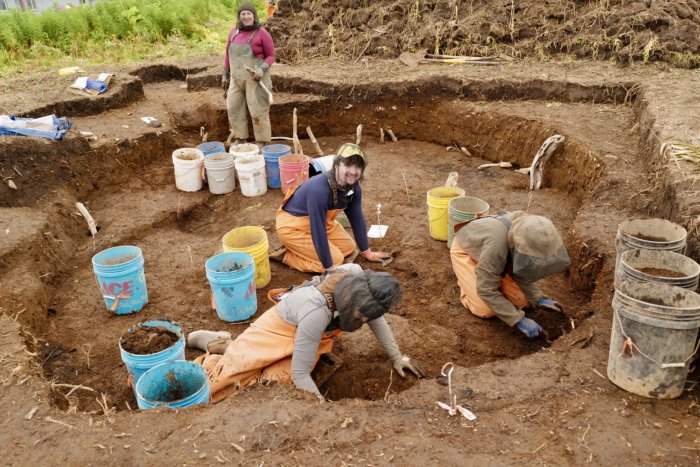Jan Bartek – AncientPages.com – Alaska’s Shuyak Island, the seventh-largest of the Kodiak islands, spans sixty-nine square miles at the northern tip of the archipelago. It measures twelve miles in length and eleven miles in width, featuring dense spruce forests and numerous small lakes. Unlike its neighboring regions, Shuyak is relatively flat, with an elevation reaching only 660 feet above sea level.
Conflict On Shuyak Island
The island’s western coast has a complex network of bays and inlets, offering more sheltered waterways than anywhere else in the archipelago. These waterways undergo significant transformations throughout the day due to twenty-foot tides that reveal reefs and clam beds, or fill channels and lagoons.

Kodiak Island map showing Shuyak Island. Credit: Kmusser – CC BY 2.5
Today, Shuyak Island is predominantly encompassed by the Shuyak Island State Park, a wilderness recreation area that draws sea kayakers, birdwatchers, fishermen, and wildlife photographers. Despite its current tranquility and absence of modern settlements, the island was historically significant to the Alutiiq nation.
Archaeological evidence reveals that Alutiiq families once resided along Shuyak’s coast, with historical documentation indicating that at least two Alutiiq villages existed there in the eighteenth century.
Early records describe how Russian entrepreneur Gregorii Shelikov established trade relations with the chief of a village. However, after an incident where villagers killed two Russian workers and a Native interpreter sent for trading purposes, Shelikov retaliated by destroying the community. It is rumored that this led to fear among the inhabitants of other Shuyak villages, who then fled from potential Russian aggression. By 1796, no Alutiiq communities remained on Shuyak Island.
In the twentieth century, the Alutiiq people returned to Shuyak Island to engage in fish harvesting. During the 1920s, individuals like Fred Sargent and Christ Opheim, along with their sons, salted salmon on Shuyak for both human consumption and as feed for the burgeoning fox farming industry. By the 1930s, entrepreneurs transformed a family-operated herring saltery in Port William on Shuyak into a facility processing salmon, herring, and halibut. This facility operated under the Washington Fish and Oyster Company until 1976. Today, archaeologists are excavating sites on the island to uncover more about its ancient history.
Several Ancient Alutiiq Villages Found
Recent archaeological surveys on an island near Kodiak have led to the discovery of new Alaska Native village sites, including one potentially identified as the oldest on the island.
The Alutiiq Museum’s archaeological team has been diligently working for several years to map out the historical timeline of these sites. Patrick Saltonstall, the archaeology curator at the Alutiiq Museum, plays a significant role in conducting site surveys and excavations throughout the Kodiak Archipelago. This spring, Saltonstall and his team completed their survey of Shuyak Island, situated about 54 air miles north of Kodiak.
Last summer, archaeologists conducted a survey of the western half of the island, and this year they focused on the eastern half. According to Saltonstall, one site they examined dates back approximately 7,000 years. This site is believed to be the oldest discovered on the island to date.
“A lot of the old research had focused on the northwest part of Shuyak Island and we surveyed the whole island. And we found a lot of really big villages on the east side.
I think we found that one village that had 11 house pits, probably had two to three hundred people living in it, you know, 300 years ago.

Kodiak, view from Pillar Mountain. Credit: Katie Walker – CC BY 2.0
Shuyak has always sort of been a place where I think it seems like there were fewer people up there. But finding that, you know what your preconceptions are and what you actually find often don’t match,” Patrick Saltonstall, the archaeology curator with the Alutiiq Museum told Alaska Public Media.
Protecting Archaeological Sites On The Island
Following the Exxon Valdez oil spill in 1989, efforts to clean up the area included surveying and safeguarding numerous archaeological sites on the island. Saltonstall noted that many of these sites were reported to be eroding and at risk of being lost to the water. Elders say the Alutiiq word Suu’aq (Shuyak) translates to “rising out of the water.” Appropriately, Saltonstall explained that the island is currently rising at a rate faster than sea level, which has reduced the immediate threat of site erosion today.

Archaeologists with the Alutiiq Museum dig into layers on layers site at Karluk Lake called site 309, which revealed a ‘super structure’. This is separate from what was surveyed on Shuyak Island. (Courtesy of Alutiiq Museum Archaeology Department & Repository)
What we found up there is that’s not happening anymore. All the sites are much more stable,” Saltonstall said. “You see grass growing on all the beaches, and it demonstrates…the land sank in 1964 and it’s rebounded ever since, and it’s outpacing sea level rise up there.
Molly Odell, the director of archaeology at the Alutiiq Museum, has highlighted that natural growth on Shuyak Island offers significant protection for archaeological sites. She noted that it’s encouraging news that these sites are experiencing less erosion compared to 30-40 years ago, indicating their stability and reduced risk of loss. Additionally, this stability provides some defense against looting.
See also: More Archaeology News
Odell emphasized the importance of not disturbing archaeological sites or collecting artifacts, as these items belong to the landowner even if found on beaches. If you encounter artifacts or cultural sites on the island, it is recommended to report your findings and share photographs with the Alutiiq Museum for proper documentation and preservation efforts.
Written by Jan Bartek – AncientPages.com Staff Writer









